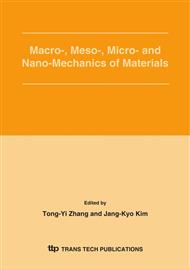p.117
p.127
p.137
p.143
p.153
p.163
p.173
p.183
p.191
Simulation of Multiple Hydraulic Fracturing in Non-Uniform Pore Pressure Field
Abstract:
A series of numerical simulations of hydraulic fracturing were performed to study the initiation, propagation and breakdown of fluid driven fractures. The simulations are conducted with a flow-coupled Rock Failure Process Analysis code (RFPA2D). Both heterogeneity and permeability of the rocks are taken into account in the studies. The simulated results reflect macroscopic failure evolution process induced by microscopic fracture subjected to porosity pressure, which are well agreeable to the character of multiple hydraulic fracturing experiments. Based on the modeling results, it is pointed out that fracture is influenced not only by pore pressure magnitude on a local scale around the fracture tip but also by the orientation and the distribution of pore pressure gradients on a global scale. The fracture initiation, the orientation of crack path, the breakdown pressure and the stress field evolution around the fracture tip are influenced considerably by the orientation of the pore pressure. The research provides valuable guidance to the designers of hydraulic fracturing engineering.
Info:
Periodical:
Pages:
163-172
Citation:
Online since:
September 2005
Price:
Сopyright:
© 2005 Trans Tech Publications Ltd. All Rights Reserved
Share:
Citation:


